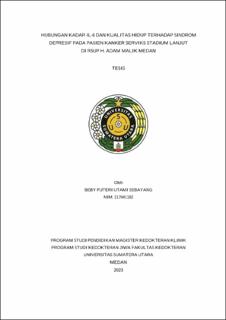Hubungan Kadar IL-6 dan Kualitas Hidup terhadap Sindrom Depresif pada Pasien Kanker Serviks Stadium Lanjut di RSUP H. Adam Malik Medan

Date
2023Author
Sebayang, Beby Puteri Utami
Advisor(s)
Effendy, Elmeida
Amin, Mustafa Mahmud
Metadata
Show full item recordAbstract
Background: Cervical cancer is a malignancy that occurs in the cervix and is caused by infection with the Human Papilloma Virus (HPV). According to data from the Indonesian Cancer Foundation, cervical cancer ranks second among the cancers that most often attack Indonesian women, with a percentage of 16%. Patients with cervical cancer have an increased risk of psychiatric symptoms such as anxiety and depression. Interleukin-6 (IL-6) is one of the cytokines associated with the development of cervical cancer. Depression is induced by various biological mechanisms. This inflammatory process is involved in the pathogenesis of depression as well as cancer and tumor-derived inflammatory cytokines such as IL-6 can cause depression in cancer patients. This study wants to analyze whether there is a relationship between IL-6 levels and quality of life on depressive syndrome in advanced cervical cancer patients.
Method: This research is a correlative analytical study with a cross-sectional study approach. Sampling used non-probability sampling technique type consecutive sampling. A sample of 61 patients with advanced cervical cancer was obtained at RSUP. H. Adam Malik Medan.
Results: Data from 61 participating advanced cervical cancer patients showed that there was a positive correlation with a strong positive correlation between IL-6 and depressive syndrome as measured by PHQ-9, where increasing levels of IL-6 resulted in an increase in the level of depressive syndrome. (PHQ-9 score value), with a value of r=0.604, n=61, and p value<0.001. There is a correlation between quality of life as measured by the SF-36 and depressive syndrome in advanced cervical cancer patients. The r value in the eta correlation test between quality of life variables and depressive syndrome based on SPSS results is 0.841. The calculated F value is 33.78 and F table is 2.37 where calculated F > F table. The conclusion was drawn that Ho was accepted or there was a correlation between quality of life and depressive syndrome in cervical cancer patients with a value of r= 0.841.
Conclusion: There is a relationship between IL-6 levels and quality of life with depressive syndrome in advanced cervical cancer patients.
